Alstroemeria - the meaning of the flower, its origin, care features
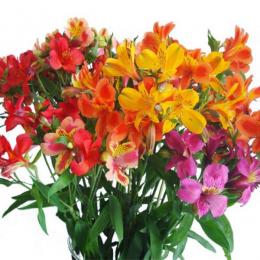
Nature is an amazing artist who creates only beautiful pictures and noble alstroemeria confirmation of this. Refined and graceful, she delights flower growers and summer residents with her beauty, who are very fond of this foreign guest.
Content:
- The history of the appearance of the Peruvian lily in bouquets
- Characteristics and botanical description of the Peruvian lily
- The main and most common types of plants
- Rules for caring for crops
- Disease and pest control
- Propagation by seeds and corms
The history of the appearance of the Peruvian lily in bouquets
The history of the meaning of the alstroemeria flower originates in Peru. The ancient Incas revered it and attached great importance to it, considering it a gift from the Sun God. They believed that the plant gave a person superpowers: the ability to disappear, move at the speed of light, or turn into animals.
Alstroemeria has many names - Peruvian lily, Lily of the Incas. The official name used for the flower was given by a Swedish botanist in the 18th century, who noticed the beauty of the plant and transported it from America to Old Europe.
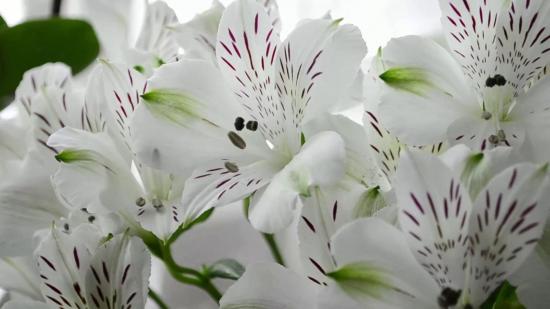
In the language of flowers, a gift of a bouquet of Peruvian lilies clearly indicates that the girl is unique and extraordinary. If this is just the beginning of a relationship, then the presented bouquet will mean the highest admiration; if the relationship has already begun, then the lily of the Incas gives a sign that the admirer is sad without a beautiful girl.
And in combination with scarlet roses In a wedding bouquet, the meaning of the alstroemeria flower can only be one: “I give my hand and heart!” These flowers are also good in bouquets because they are suitable for any bride and have no fragrance, so even allergy sufferers have no reason to worry or worry.
Characteristics and botanical description of the Peruvian lily
Belongs to the Alstroemeriaceae family, is a perennial herbaceous plant with numerous outgrowths on the roots. It is widespread in the countries of South America, and is also often found in natural conditions in Bolivia, Peru, the Andes and Chile.
The stems are straight and reach up to one and a half meters in height, so when growing them you need a garter to the supports. The leaves are green, linear, lanceolate, most of them are located in the upper part, the flowers themselves are very similar to orchid, the cup contains 6 petals located in two equal circles.
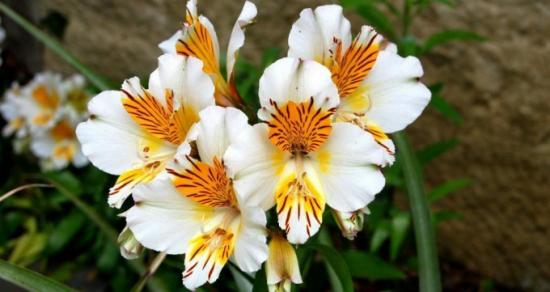
An inflorescence contains 12-20 flowers of various shades: white, lilac, yellow, red, pink, brown, many varieties with spots on the petals. The fruit is a capsule with seeds.
Foreign guests are grown in greenhouses, winter gardens, in apartments in pots, also as garden plants, to decorate flower beds and plots, but are used for this purpose hybrids, frost-resistant.
The main and most common types of plants
There are about 128 plant species in the genus, the most famous of them.
Golden alstroemeria lives naturally in Chile. Grows up to 80-90 cm, flowers are orange, brownish with a yellow core and dark spots.
Brazilian is a tall bush, reaching a height of 2 meters.Originally from Brazil, it has pointed leaves and bright inflorescences with a large number (about 30) of orange and brown flowers.
Virginia is a snow-white variety with large flowers and dark specks on white petals. Originally from the state of the same name in America, it is often used in floral arrangements.
Pretty is a small bush that grows up to 50-60 cm. Its stems are spreading, crowned with variegated pink-yellow buds with numerous specks.
Alicia is a hybrid variety with buds vaguely resembling rose. The color is soft pink with a white tone and spots. Blooms all summer until autumn.
Blood red is characterized by the presence of fleshy roots, a bright red color with a divisible core and many buds in the inflorescence, approximately 15-17 pieces.
Ligtu is an interesting species bred in Great Britain. After flowering, it dies completely, has a salmon-pink color and a yellow core with dark inclusions. Is frost-resistant variety with high decorative qualities.
Regina is an interesting species, characterized by flowers of pink tones with unusual fancy dark touches. This variety blooms from June to mid-September.
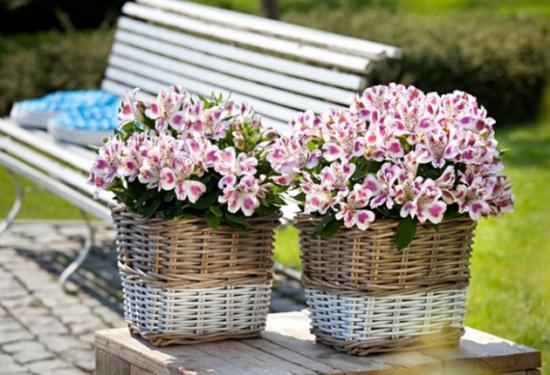
Alstroemeria is a beautiful, exotic species, which is why flower growers love it and often use it to decorate flower beds and rockeries. A fairly tall shrub, excellent for forming zones in landscape design.
Particularly popular and good combinations are the fragility of the Peruvian lilies and the relics of thorned roses, delicate duets with chrysanthemums. The location next to gerberas. It is grown on a large scale for cutting, in floristry for making bouquets and numerous flower arrangements.Such bouquets have a special charm, although the lily of the Incas does not retain its freshness for long.
Rules for caring for crops
The Lily of the Incas, although a foreign guest, is not capricious and difficult to grow.
It is enough to follow some rules when caring for it.
Landing location
It is important to choose a place that is well lit, but shaded from direct sunlight during lunchtime. For cold periods, southern windows are suitable, and for warm periods, eastern, western or southern ones with shading during the hottest hours.
Temperature
For alstroemeria, a room temperature of 20-23 degrees is desirable in the warm season; in winter, a decrease to 15 degrees is permissible. But it is not frosts that are truly destructive for alstroemeria, but hot, high temperatures.
Above 27-28 degrees it stops growing, sheds its leaves, and begins to dry out. Buds for future buds stop forming. A good prevention of dry air is to frequently spray the flower with a spray bottle.
Watering
Watering for the Peruvian lily you need constant, without oversaturation of soil moisture. It is advisable to use soft water with the least amount of chlorine. Before the next watering, the soil should dry out a little, and during the flowering period, on the contrary, it should always be slightly damp. Avoid stagnant processes in the roots of the plant; alstroemeria does not like this and begins to rot.
The soil
The soil should be light and allow the necessary oxygen to reach the roots. Optimal soil composition: leaf soil, humus or peat, vermiculite and pine bark in a ratio of 2:1:1:1. With low acidity (6-7 ph). Heavy soils have a detrimental effect on flower growth and flowering. The nitrogen content of the soil should also be monitored.
But phosphorus-potassium fertilizers are perfect and are loved by the plant. It is necessary to feed with mineral fertilizers regularly, once a month.
The first feeding is complex, and later nitrogen is excluded from the composition. During the flowering period, it is recommended to water with a solution containing ash: 1 tablespoon per 3 liters of water.
Disease and pest control
The crop is not easily damaged by disease, but it is still worth carrying out preventive treatments with Fundazol several times a year. The most common pests on the plant are spider mites, mealybugs, thrips, common aphid. “Aktara”, “Fitoverm”, “Karbafos” cope well with them.
Propagation by seeds and corms
Reproduction is possible in several ways:
- Seeds.
- Dividing rhizomes and corms.
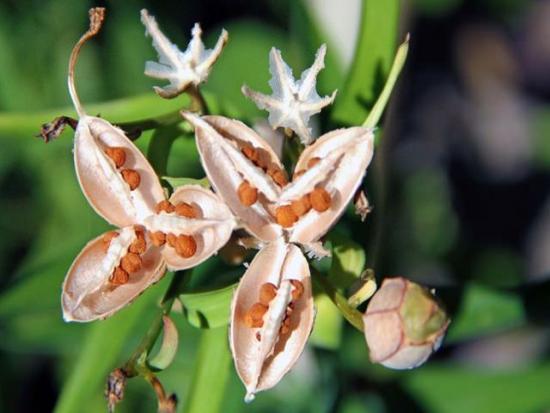
For seedlings, closer to the beginning of spring, it is necessary to prepare nutritious soil. You can make it yourself; to do this, mix turf soil with coarse sand and leaf soil. Or they buy it ready-made in specialized flower shops. When the mixture is ready, it needs to be disinfected; to do this, place the soil mixture in the oven for a while.
Expanded clay is poured into a container with large drainage holes for future seedlings, and ready-made soil is placed on top.
Distribute evenly on the surface of the planting container. seeds, press them in and sprinkle them with a thin layer of soil mixture.
Pots with seeds are covered with glass or plastic wrap and put in a cool place: on the balcony or on the bottom shelf of the refrigerator, periodically removing the container and ventilating it to avoid the appearance of rot and fungus. After about a month, the container is moved to a warm and well-lit place with a temperature of 21-25 degrees.
For rapid seedling growth, long daylight hours of about 12 hours and frequent watering are required.
When full 2-3 leaves appear, each plant is transplanted into a separate pot for growing, or immediately into a pot where the Peruvian lily will grow in the near future. Flowering when growing seedlings from seeds should be expected in the 2nd or 3rd year of the plant’s life.
Propagation by corms
To start working with them, the bulbs are well prepared:
- To avoid infection, the corm is kept in a raspberry solution of potassium permanganate, then rinsed with clean water and dried.
- If reproduction occurs in the spring, then the tubers are soaked in a solution with biological growth stimulants, so the plants will grow faster and become stronger. If it is autumn, there is no need to treat with biostimulants so that the first shoots are not damaged during frosts.
- The bulbs are planted in a pot to a depth of 15-20 cm, covered with soil and thoroughly watered generously. During flowering and budding of the crop, carefully monitor the pruning and timely removal of dried, faded leaves and flowers so that the crop does not waste extra energy and juices on them.
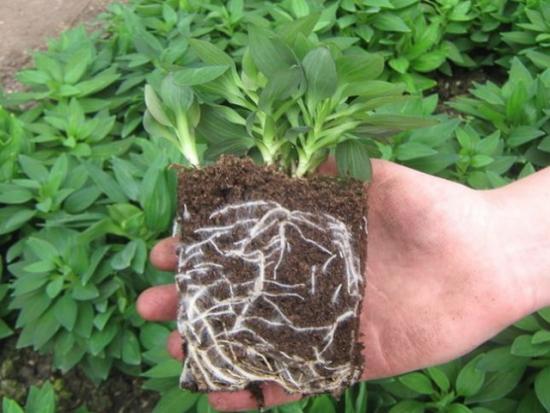
As you can see, growing a beautiful Peruvian lily is not difficult or labor intensive; it is enough to adhere to certain terms and rules for caring for the plant. And the beauty and exoticism cannot leave any gardener indifferent.
Amazing alstroemeria has a rich history, is valued by florists for its unique exotic beauty and is good for growing at home. It is worth making a little effort and following all the recommendations and constant bright bloom will not keep you waiting.
You can appreciate the beauty of the plant and learn how to properly care for it by watching the video:


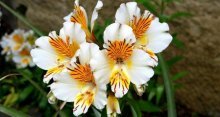

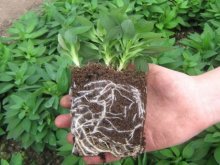

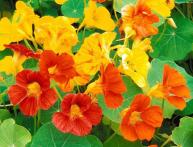
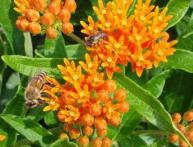
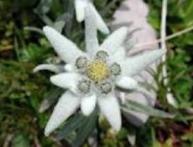
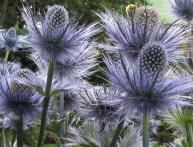
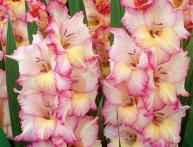

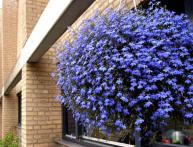
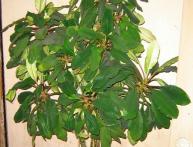
Comments
What beautiful flowers! I’m not very familiar with alstroemeria, I’ve mostly seen them in bouquets, but I haven’t grown them myself, but, armed with all the recommendations and advice, I’ll definitely try it.
I love this flower very much, but, unfortunately, in our country it is not yet popular enough. In any case, I often hear people say, “Oh, what kind of flower is this?” I care for alstroemerias like ordinary lilies; I planted them in the shade, under a large pear tree. The main thing is not to overwater them, then they will live and bloom for a long time.